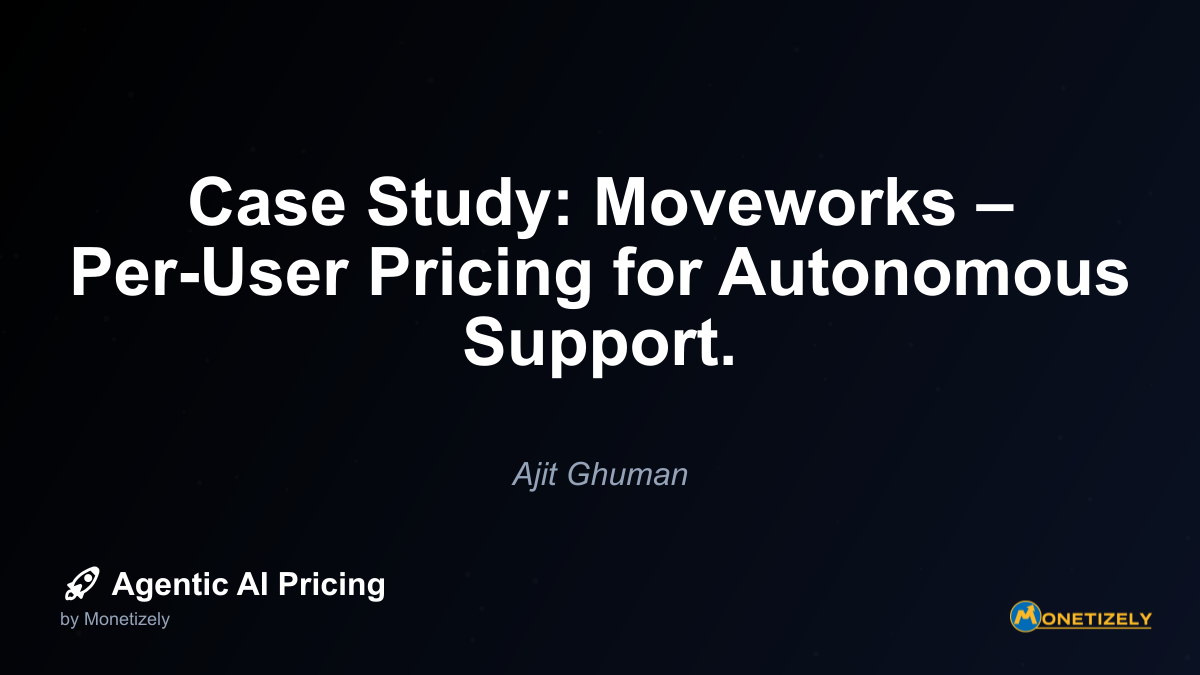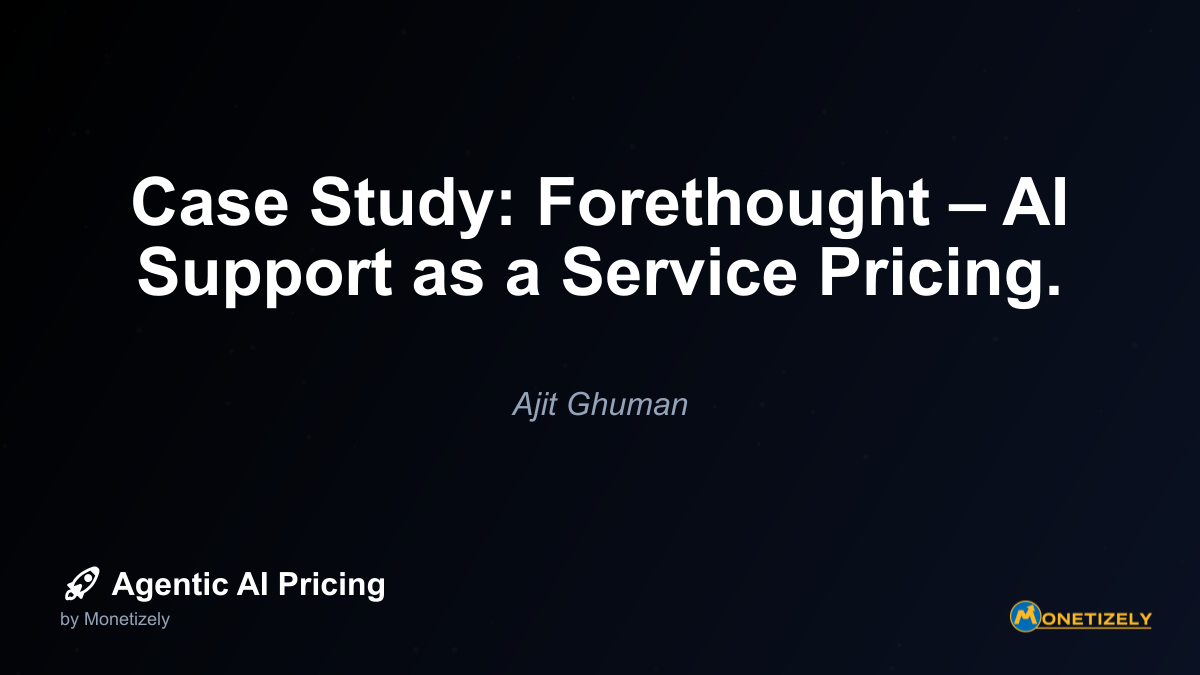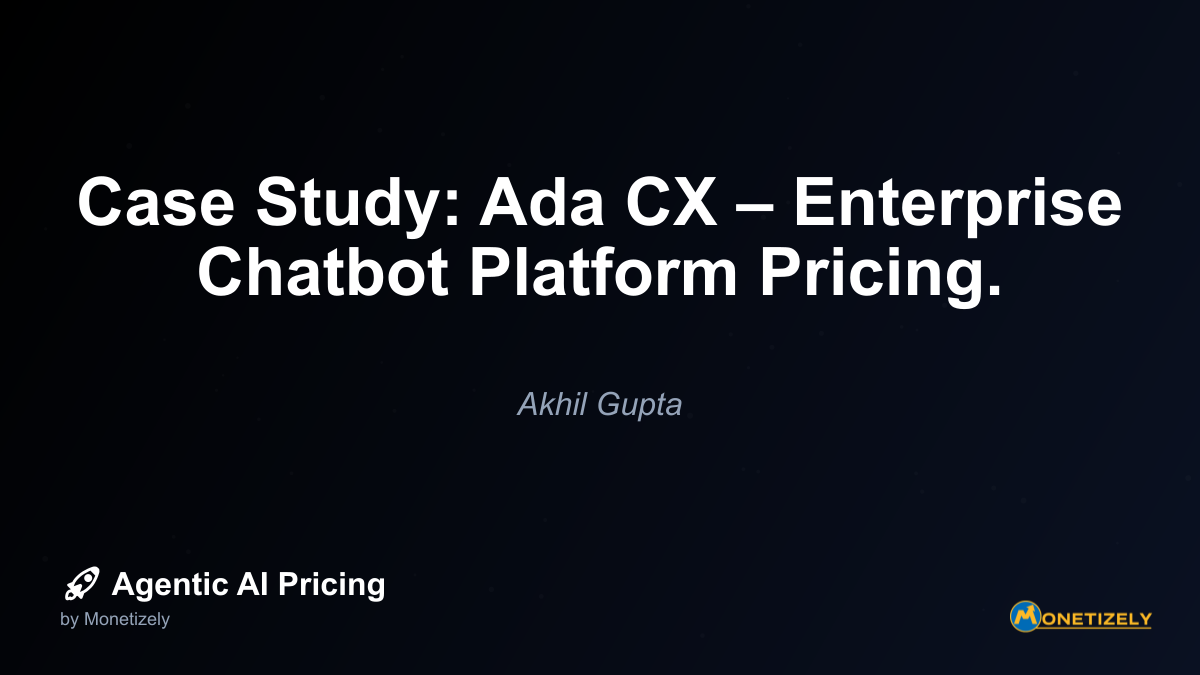· Ajit Ghuman · Case Studies · 6 min read
Case Study: Moveworks – Per-User Pricing for Autonomous Support.
AI and SaaS Pricing Masterclass
Learn the art of strategic pricing directly from industry experts. Our comprehensive course provides frameworks and methodologies for optimizing your pricing strategy in the evolving AI landscape. Earn a professional certification that can be imported directly to your LinkedIn profile.

When calculating the ROI for Moveworks’ implementation, organizations typically focus on three key metrics:
- Time Saved per Ticket: The average time reduction in resolving support issues (often measured in hours)
- Volume of Tickets Automated: The percentage of total support tickets that Moveworks can handle without human intervention
- Average Employee Hourly Cost: The fully-loaded cost of employee time, including benefits and overhead
A simplified ROI calculation might look like:
Annual ROI = (Time Saved per Ticket × Volume of Tickets × Average Employee Hourly Cost) - Moveworks Annual CostFor a mid-sized enterprise with 5,000 employees generating an average of 3 support tickets per employee annually, with each ticket typically taking 45 minutes of employee time plus 30 minutes of IT staff time, the calculation becomes compelling:
- 15,000 annual tickets
- 75,000 employee hours potentially lost to waiting/resolving issues
- 7,500 IT staff hours spent on ticket resolution
If Moveworks can automate 60% of these tickets and reduce resolution time to minutes instead of hours, the time savings quickly justify the $100-$200 per user annual investment.
Calculating Total Cost of Ownership
When evaluating Moveworks’ pricing model, organizations must consider several factors beyond the per-user fee:
Implementation and Integration Costs
While Moveworks is designed to integrate with existing systems, there are still implementation costs to consider, including:
- IT resources needed for integration with existing systems
- Data preparation and knowledge base structuring
- Change management and employee training
Ongoing Management
Though significantly less resource-intensive than traditional support systems, Moveworks still requires some oversight:
- Periodic review of AI performance and accuracy
- Knowledge base updates and maintenance
- Administrative oversight of the platform
Contract Structure Considerations
Enterprises should evaluate several aspects of Moveworks’ contractual terms:
- Contract length (typically multi-year commitments)
- Minimum user thresholds
- Annual price increase limitations
- Service level agreements (SLAs) for AI performance
How Moveworks’ Pricing Compares to Alternatives
Moveworks’ per-user pricing model differs from several alternative approaches in the AI support space:
Ticket-Based Pricing
Some competitors charge per ticket resolved, which can create unpredictable costs and potentially discourage usage. Moveworks’ unlimited usage approach eliminates this concern.
Tiered Feature-Based Pricing
Other platforms offer different capability tiers at varying price points. Moveworks generally provides its full feature set to all customers, with some enterprise-specific capabilities for larger organizations.
Hybrid Human+AI Models
Some support solutions combine AI with human agents, charging blended rates. Moveworks focuses on maximizing automation, with pricing that reflects this autonomous approach.
For a deeper exploration of AI agent ROI calculations, organizations can consider more sophisticated models that account for both direct and indirect benefits.
Strategic Implications for AI Pricing
Moveworks’ approach to pricing offers several valuable lessons for other agentic AI companies:
1. Align Pricing with Familiar Metrics
By using employee count as the pricing basis, Moveworks connects its value to a metric that enterprises already understand and budget around. This reduces friction in the purchase decision process.
2. Emphasize Total Value Over Usage
Rather than charging for consumption (queries, tokens, or compute time), Moveworks prices based on the population served. This shifts the conversation from “How much will we use?” to “How much value will we create?“
3. Leverage the Unlimited Model
The unlimited usage approach within the per-user fee structure encourages adoption and removes internal barriers to utilization. This drives deeper integration into organizational workflows and increases switching costs over time.
4. Focus on Measurable Outcomes
Moveworks’ sales approach heavily emphasizes ROI calculations based on time savings and productivity improvements. This outcomes-based selling aligns with enterprise buying processes that require clear justification for technology investments.
Implementation Challenges and Considerations
Despite its straightforward pricing model, organizations implementing Moveworks face several challenges:
Adoption and Change Management
For Moveworks to deliver its promised ROI, employees must actually use the system instead of traditional support channels. This requires effective change management and internal marketing.
Integration Complexity
The value of Moveworks increases with the number of systems it can access and actions it can perform. This requires thoughtful integration with existing enterprise systems, which can vary in complexity.
Knowledge Base Quality
Moveworks’ effectiveness depends partly on the quality and completeness of an organization’s knowledge bases. Many enterprises find they need to improve their documentation as part of implementation.
Cultural Resistance
Some organizations face resistance from support staff who fear automation will threaten their roles. Successful implementations reframe this narrative to focus on how AI handles routine tasks while elevating human roles.
Future Evolution of Moveworks’ Pricing Model
As the autonomous support market matures, we may see Moveworks and similar vendors evolve their pricing approaches:
Value-Based Tiers
Future iterations might introduce different service tiers based on the complexity of support provided or the number of integrated systems.
Outcome-Based Components
We might see elements of outcome-based pricing, where a portion of fees is tied to actual performance metrics like automation rates or time savings.
Industry-Specific Packaging
As Moveworks expands its capabilities, we could see specialized versions with pricing tailored to specific industries with unique support requirements.
AI Capability Expansion
As the platform’s capabilities grow beyond traditional support into proactive assistance and workflow automation, pricing might evolve to reflect this expanded value proposition.
Lessons for Other Agentic AI Companies
Moveworks’ pricing strategy offers several valuable insights for other companies developing agentic AI solutions:
Find the Right Value Metric
The per-user model works for Moveworks because it naturally scales with value delivered. Other AI solutions should identify their own most appropriate value metric – whether that’s users, data volume, transactions processed, or something else entirely.
Make ROI Calculation Simple
Moveworks provides clear ROI models that customers can easily adapt to their specific situations. This transparency accelerates buying decisions.
Balance Simplicity and Accuracy
While more complex pricing models might more precisely capture value, they also create friction in the sales process. Moveworks’ relatively simple approach prioritizes ease of understanding.
Create Natural Expansion Paths
The per-user model creates a natural expansion path as customer organizations grow, without requiring complex upselling or renegotiation.
Conclusion
Moveworks’ per-user pricing model for its autonomous support platform represents a thoughtful approach to monetizing agentic AI in the enterprise context. By charging based on employee count rather than usage metrics, the company aligns its pricing with the scope of value delivered while creating predictability for both customers and its own revenue forecasting.
This approach successfully bridges traditional SaaS pricing conventions with the unique value proposition of autonomous AI systems. It enables straightforward ROI calculations while encouraging widespread adoption through unlimited usage allowances.
For other companies developing agentic AI solutions, Moveworks offers a valuable case study in effective pricing strategy. While not every AI product will fit the per-user model, the principles of value alignment, simplicity, and outcome focus provide a solid foundation for developing pricing approaches that accelerate market adoption while capturing appropriate value.
As the agentic AI market continues to evolve, we can expect further innovations in pricing models. However, Moveworks’ approach demonstrates that sometimes the most effective strategy isn’t to reinvent pricing entirely, but rather to adapt familiar models to new technology paradigms in ways that resonate with enterprise buyers.
Co-Founder & CEO
Ajit is the author of Price To Scale, a top book on SaaS Pricing and is the Founder of Monetizely. Ajit has led and worked in pricing and product marketing at firms like Twilio, Narvar and Medallia. His work has been featured in Forbes and VentureBeat. Ajit regularly consults with software companies from Seed stage to post-IPO on pricing strategy. Ajit is also a highly-rated co-instructor for 'The Art of SaaS Pricing and Monetization' on Maven.
Pricing Strategy Audit
Let our experts analyze your current pricing strategy and identify opportunities for improvement. Our data-driven assessment will help you unlock untapped revenue potential and optimize your AI pricing approach.




